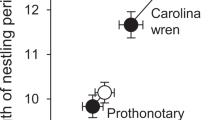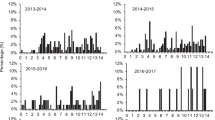Abstract
The effects of climate change on populations are complex and difficult to predict, and can result in mismatches between interdependent organisms or between organisms and their environment. Reptiles with temperature-dependent sex determination may be able to compensate for potential skews in offspring sex ratio caused by climate change by selecting cooler (i.e., shadier) nest sites. Although changing nest location may prevent sex ratio skews, it may also affect thermally sensitive performance traits in offspring. I tested righting, sprinting, and swimming performance in hatchling painted turtles (Chrysemys picta), produced by female turtles from five populations across the species’ geographic range, nesting in a common-garden environment. I found that speed of hatchling performance was faster in hatchlings whose mothers originated from warmer climates, and that nests with higher mean daily variation in incubation temperature produced faster hatchlings. These results suggest that the increased temperatures predicted by climate change models could result in hatchling turtles that are faster at sprinting and swimming; however, it is not yet known how these performance measures translate into fitness.



Similar content being viewed by others

References
Ashmore GM, Janzen FJ (2003) Phenotypic variation in smooth softshell turtles (Apalone mutica) from eggs incubated in constant versus fluctuating temperatures. Oecologia 134:182–188
Atkins KE, Travis JMJ (2010) Local adaptation and the evolution of species’ ranges under climate change. J Theor Biol 266:449–457
Balanyá J, Oller JM, Huey RB, Gilchrist GW, Serra L (2006) Global genetic change tracks global climate warming in Drosophila subobscura. Science 313:1773–1775
Baynes SM, Howell BR (1996) The influence of egg size and incubation temperature on the condition of Solea solea (L.) larvae at hatching and first feeding. J Exp Mar Biol Ecol 199:59–77
Beebee TJC (1995) Amphibian breeding and climate. Nature 374:219–220
Berteaux D, Réale D, McAdam AG, Boutin S (2004) Keeping pace with fast climate change: can Arctic life count on evolution? Integr Comp Biol 44:140–151
Bradley NL, Leopold AC, Ross J, Huffaker W (1999) Phenological changes reflect climate change in Wisconsin. Proc Natl Acad Sci USA 96:9701–9704
Bradshaw WE, Holzapfel CM (2001) Genetic shift in photoperiodic response correlated with global warming. Proc Natl Acad Sci USA 98:14509–14511
Brooks RJ, Bobyn ML, Galbraith DA, Layfield JA, Nancekivell EG (1991) Maternal and environmental influences on growth and survival of embryonic and hatchling snapping turtles (Chelydra serpentina). Can J Zool 69:2667–2676
Brown GP, Shine R (2004) Maternal nest-site choice and offspring fitness in a tropical snake (Tropidonophis mairii, Colubridae). Ecology 85:1627–1634
Bulmer MG, Bull JJ (1982) Models of polygenic sex determination and sex ratio control. Evolution 36:13–26
Burger J (1976) Behavior of hatchling diamondback terrapins (Malaclemys terrapin) in the field. Copeia 1976:742–748
Burger J (1989) Incubation temperature has long-term effects on behaviour of young pine snakes (Pituophis melanoleucus). Behav Ecol Sociobiol 24:201–207
Burnham KP, Anderson DR (2002) Model selection and multimodel inference: a practical information-theoretic approach. Springer, New York
Colbert PL, Spencer R-J, Janzen FJ (2010) Mechanism and cost of synchronous hatching. Funct Ecol 24:112–121
Crick HQP, Dudley C, Glue DE, Thomson DL (1997) UK birds are laying eggs earlier. Nature 388:526
Delmas V, Baudry E, Girondot M, Prevot-Julliard A (2007) The righting response as a fitness index in freshwater turtles. Biol J Linn Soc 91:99–109
Demuth JP (2001) The effects of constant and fluctuating incubation temperatures on sex determination, growth, and performance in the tortoise Gopherus polyphemus. Can J Zool 79:1609–1620
Du W-G, Ji X (2003) The effects of incubation thermal environments on size, locomotor performance and early growth of hatchling soft-shelled turtles, Pelodiscus sinensis. J Therm Biol 28:279–286
Ernst CH (1971) Population dynamics and activity cycles of Chrysemys picta in southeastern Pennsylvania. J Herpetol 5:151–160
Ewert MA, Jackson DR, Nelson CE (1994) Patterns of temperature-dependent sex determination in turtles. J Exp Zool 270:3–15
Frazer GW, Canham CD, Lertzman KP (1999) Gap Light Analyzer (GLA), Version 2.0: Imaging software to extract canopy structure and gap light transmission indices from true-colour fisheye photographs. Simon Fraser University, Burnaby, BC
Freedberg S, Ewert MA, Nelson CE (2001) Environmental effects on fitness and consequences for sex allocation in a reptile with environmental sex determination. Evol Ecol Res 3:953–967
Freedberg S, Stumpf AL, Ewert MA, Nelson CE (2004) Developmental environment has long-lasting effects on behavioural performance in two turtles with environmental sex determination. Evol Ecol Res 6:739–747
Inouye DW, Barr B, Armitage KB, Inouye BD (2000) Climate change is affecting altitudinal migrants and hibernating species. Proc Natl Acad Sci USA 97:1630–1633
Jankowski JE, Robinson SK, Levey DJ (2010) Squeezed at the top: interspecific aggression may constrain elevational ranges in tropical birds. Ecology 91:1877–1884
Janzen FJ (1993) An experimental analysis of natural selection on body size of hatchling turtles. Ecology 74:332–341
Janzen FJ (1994) Climate change and temperature-dependent sex determination in reptiles. Proc Natl Acad Sci USA 91:7487–7490
Janzen FJ (1995) Experimental evidence for the evolutionary significance of temperature-dependent sex determination. Evolution 49:864–873
Janzen FJ, Tucker JK, Paukstis GL (2000) Experimental analysis of an early life-history stage: selection on size of hatchling turtles. Ecology 81:2290–2304
Jayne BC, Bennett AF (1990) Selection on locomotor performance capacity in a natural population of garter snakes. Evolution 44:1204–1229
Kolbe JJ, Janzen FJ (2002) Experimental analysis of an early life-history stage: water loss and migrating hatchling turtles. Copeia 2002:220–226
Kutz SJ, Hoberg EP, Polley L, Jenkins EJ (2005) Global warming is changing the dynamics of Arctic host–parasite systems. Proc R Soc Lond B 272:2572–2576
Les HL, Paitz RT, Bowden RM (2007) Experimental test of the effects of fluctuating incubation temperatures on hatchling phenotype. J Exp Zool A 307:274–280
Les HL, Paitz RT, Bowden RM (2009) Living at extremes: development at the edges of viable temperature under constant and fluctuating conditions. Physiol Biochem Zool 82:105–112
McGaugh SE, Janzen FJ (2011) Effective heritability of targets of sex-ratio selection under environmental sex determination. J Evol Biol 24:784–794
McGaugh SE, Schwanz LE, Bowden RM, Gonzalez JE, Janzen FJ (2010) Inheritance of nesting behaviour across natural environmental variation in a turtle with temperature-dependent sex determination. Proc R Soc Lond B 277:1219–1226
McGaugh SE, Bowden RM, Kuo C-H, Janzen FJ (2011) Field-measured heritability of the threshold for sex determination in a turtle with temperature-dependent sex determination. Evol Ecol Res 13:75–90
Miller K (1993) The improved performance of snapping turtles (Chelydra serpentina) hatched from eggs incubated on a wet substrate persists through the neonatal period. J Herpetol 27:228–233
Miller K, Packard GC, Packard MJ (1987) Hydric conditions during incubation influence locomotor performance of hatchling snapping turtles. J Exp Biol 127:401–412
Morjan CL (2003a) How rapidly can maternal behavior affecting primary sex ratio evolve in a reptile with environmental sex determination? Am Nat 162:205–219
Morjan CL (2003b) Variation in nesting patterns affecting nest temperatures in two populations of painted turtles (Chrysemys picta) with temperature-dependent sex determination. Behav Ecol Sociobiol 53:254–261
Mullins MA, Janzen FJ (2006) Phenotypic effects of thermal means and variances on smooth softshell turtle (Apalone mutica) embryos and hatchlings. Herpetologica 62:27–36
Nelson NJ, Thompson MB, Pledger S, Keall SN, Daugherty CJ (2004) Do TSD, sex ratios, and nest characteristics influence the vulnerability of tuatara to global warming? Int Congr Ser 1275:250–257
Neuwald JL, Valenzuela N (2011) The lesser known challenge of climate change: thermal variance and sex-reversal in vertebrates with temperature-dependent sex determination. PLoS One 6:e18117
Nussey DH, Postma E, Gienapp P, Visser ME (2005) Selection on heritable phenotypic plasticity in a wild bird population. Science 310:304–306
Paitz RT, Harms HK, Bowden RM, Janzen FJ (2007) Experience pays: offspring survival increases with female age. Biol Lett 3:44–46
Parmesan C, Ryrholm N, Stefanescu C, Hill JK, Thomas CD, Descimon H, Huntley B, Kaila L, Kullberg J, Tammaru T, Tennent WJ, Thomas JA, Warren M (1999) Poleward shifts in geographical ranges of butterfly species associated with regional warming. Nature 399:579–583
Paukstis GL, Shuman RD, Janzen FJ (1989) Supercooling and freeze tolerance in hatchling painted turtles (Chrysemys picta). Can J Zool 67:1082–1084
Pen I, Uller T, Feldmeyer B, Harts A, While GM, Wapstra E (2010) Climate-driven population divergence in sex-determining systems. Nature 468:436–439
Refsnider JM, Janzen FJ (2010) Putting eggs in one basket: ecological and evolutionary hypotheses for variation in oviposition-site choice. Annu Rev Ecol Evol Syst 41:39–57
Refsnider JM, Janzen FJ (2012) Behavioural plasticity may compensate for climate change in a long-lived reptile with temperature-dependent sex determination. Biol Conserv 152:90–95
Rodríguez-Muñcoz R, Nicieza AG, Braña F (2001) Effects of temperature on developmental performance, survival and growth of sea lamprey embryos. J Fish Biol 58:475–486
Schwanz LA, Spencer R-J, Bowden RM, Janzen FJ (2010) Climate and predation dominate juvenile and adult recruitment in a turtle with temperature-dependent sex determination. Ecology 91:3016–3026
Solomon S, Qin D, Manning M, Chen Z, Marquis M, Averyt KB, Tignor M, Miller HL (2007) Contribution of working group I to the fourth assessment report of the intergovernmental panel on climate change. Cambridge University Press, Cambridge
Strickland JT, Janzen FJ (2010) Impacts of anthropogenic structures on predation of painted turtle (Chrysemys picta) nests. Chelonian Conserv Biol 9:131–135
Umina PA, Weeks AR, Kearney MR, McKechnie SW, Hoffmann AA (2005) A rapid shift in a classic clinal pattern in Drosophila reflecting climate change. Science 308:691–693
Van Damme R, Bauwens D, Braña F, Verheyen RF (1992) Incubation temperature differentially affects hatching time, egg survival, and hatchling performance in the lizard Podarcis muralis. Herpetologica 48:220–228
Visser ME, Both C (2005) Shifts in phenology due to global climate change: the need for a yardstick. Proc R Soc Lond B 272:2561–2569
Wapstra E, Uller T, Olsson M, Sinn DL, Mazurek K, Joss JMP, Shine R (2009) Climate effects on offspring sex ratio in a viviparous lizard. J Anim Ecol 78:84–90
Watkins TB, Vraspir J (2006) Both incubation temperature and posthatching temperature affect swimming performance and morphology of wood frog tadpoles (Rana sylvatica). Physiol Biochem Zool 79:140–149
Weisrock DW, Janzen FJ (1999) Thermal and fitness-related consequences of nest location in painted turtles (Chrysemys picta). Funct Ecol 13:94–101
Woolverton E (1963) Winter survival of hatchling painted turtles in northern Minnesota. Copeia 1963:570–571
Acknowledgments
Funding for this study came from the Iowa Academy of Sciences, Society for Integrative and Comparative Biology, Society for the Study of Amphibians and Reptiles and the Dean Metter Memorial Fund, Sigma Xi, and Iowa State University’s Department of Ecology, Evolution, and Organismal Biology. Thanks to J. Clapp and M. Fritz for collecting permits, and C. Lee for hospitality at Bosque del Apache NWR. R. Alverio-Newton, K. Christensen, R. Clayton, E. Holman, N. Howell, J. Kubik, T. Mitchell, J. Stuart, H. Streby, J. Strickland, and D. Warner helped with animal collection and maintenance of the experimental ponds. This manuscript was much improved by valuable comments from F. Janzen, A. Bronikowski, P. Dixon, C. Kelly, E. Takle, H. Streby, the Janzen Herpetology Lab at Iowa State University, and two anonymous reviewers. All research was conducted in accordance with Institutional Animal Care and Use Committee protocol #1-09-6677-J (Iowa State University).
Author information
Authors and Affiliations
Corresponding author
About this article
Cite this article
Refsnider, J.M. High thermal variance in naturally incubated turtle nests produces faster offspring. J Ethol 31, 85–93 (2013). https://doi.org/10.1007/s10164-012-0354-9
Received:
Accepted:
Published:
Issue Date:
DOI: https://doi.org/10.1007/s10164-012-0354-9



